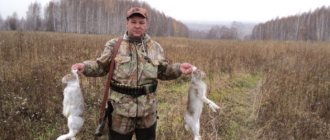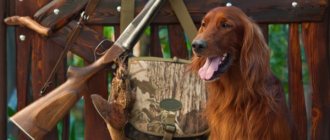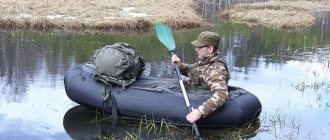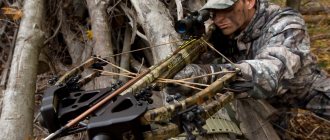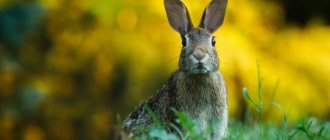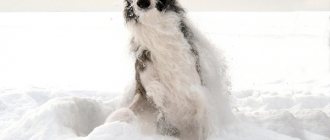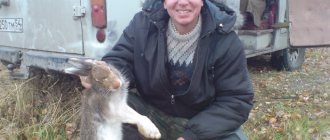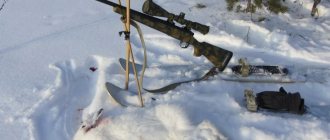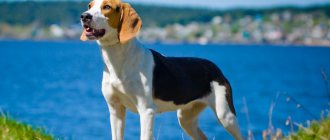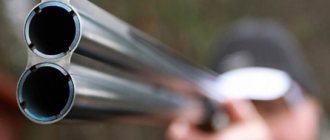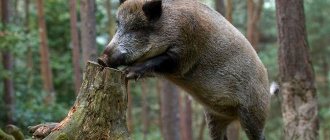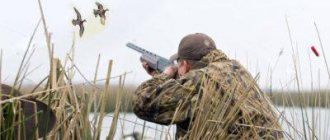What should a good hound be like?
The main sign of a good hound is its impeccable sense of smell. The scent glands of the hare are located on the pads of the paws. For this reason, it is very difficult to track down an immovable animal. When driving a hare from its resting place, the hound picks up the scent of the prey and pursues it. Endurance is no less important for a hound. Chasing prey for many hours requires a large supply of energy and strength.
At the same time, the hunter must understand that the dog is not his servant, but a partner, on whom he depends no less than on a person. Respect for your “colleague” makes the hunt productive. In essence, the hunter plays the role of a mentor who guides the hound along the right track.
Surge training
Beagle training begins when dogs are between 9 and 10 months old. Training begins with a surge, the ideal time for which is considered to be the beginning of autumn. Puppies are trained to sniff out tracks and follow the owner's commands. Their preparation begins with hare fats, where traces of their vital activity can be found. For the first training in nature, choose places where there are quite a lot of them. Then the task gets more complicated. Every day the dog moves further and further away from the beast.
To ensure that the puppies do not get tired of hunting, they are taken out to the field for training every other day. Their training begins in the fields. This is due to the fact that puppies feel more confident in them than in the forest or swamp. The hound has a good memory. Having once raised an animal from some place, the dogs will continue to check it.
The owner of a hound can always determine by its voice what animal it has discovered and is pursuing. The dog's silence means that it has lost the trail.
How to train a hound to chase a hare?
Dog training should be done regularly throughout the year. Tasks that are different from each other guarantee better results. Particular attention should be paid to the physical training of the hound - running loads and preparing the paws for the forest (the hardened pads on the dog’s toes will ensure safety when moving over rough terrain). One option for training a hound to run at a stable, but not maximum, pace is to walk next to its owner riding a bicycle. The faster the dog chases the hare, the faster it will run away. At a low pace of the chase, the hare will periodically stop, which will make it easier for the hunter to aim and shoot.
Chasing a hare
Dogs begin preparing for hunting at the age of ten months. The preferred period is spring, since during this period the breeding of hares begins, forest and field paths are covered with odorous secretions. Training should start early in the morning. It should be remembered that in spring and summer, dogs are prohibited in hunting zones. The exception is areas prepared for this.
In the fall, training is also necessary for those dogs that have already been trained and participated in hunting before. During the first hunt, young hounds can be allowed to catch up and fight the hare a little. But under no circumstances should you be allowed to eat it ! You can reward your dog with a “pazanka” - a hare’s foot cut off from the prey. This should be done after each successful run.
This is interesting: Sleds for winter fishing: how to choose the best model or make it yourself
To make the hunt successful
A successful hunt is the result of close interaction between hunter and hound. What is needed for this? Not so much:
- Start hunting in the immediate vicinity of the hare's bed. A few circles and loops - and the hare rushes back. That's where you should wait for him.
- When choosing clothes, consider the color of the environment. The hunter should not stand out against the background of the landscape.
- All movements should be confident, but unhurried. The hare does not pay attention to static objects. Therefore, waiting near the bed in a motionless stance can lead to the hare itself bumping into you, suspecting nothing.
- When setting up an ambush, take into account the direction of the wind. Do not stand in the wind; let the hare run out from the leeward side.
- Make sure the area is clearly visible. You should not be disturbed by grass, bushes, trees, hills, ravines, boulders.
- If you smoke, give up cigarettes while hunting. Tobacco smoke will give you away to the hare.
- Carefully study the lifestyle and habits of hares. Remember that the hare and the hare prefer different living conditions.
Boar
Hunting ungulates with hounds does not require specific skills from a person. For this purpose, you can use dogs that do not have a breed. The most important thing is that there are at least twenty of them. Hunting a wild boar is a rather dangerous activity, so the flock of pets should be as large as possible.
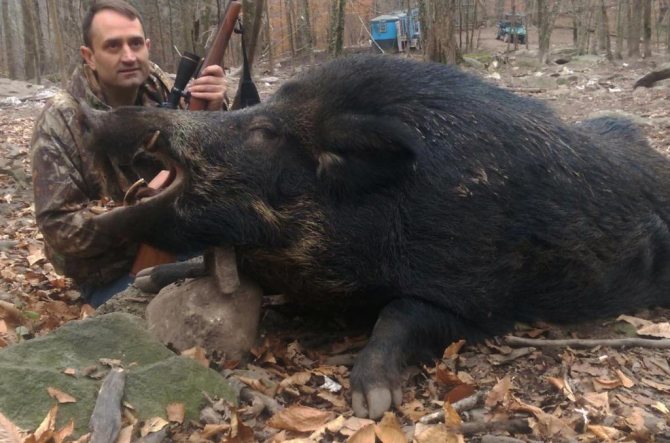
This type of hunting in most cases is carried out using a stationary method. First, the manager places shooters in several places, after which he gives a signal to start the rut. As soon as the dogs attack the boar's trail, it will be driven to the shooting line. In some cases, beaters may join the rut to prevent the boar from going backwards or to the side.
Remember that a wounded cleaver is a rather formidable opponent, so you need to kill him with one shot. Otherwise, the hunt will not be complete without the death of pets or serious injuries.
We hope our article helped you better understand what hunting with Russian hounds is like. If you train your assistant correctly and follow the recommendations given in the article, then the hunt will definitely end in great success.
How to protect your hound from wolves?
Wolves are frequent guests of hunting grounds. This fact cannot be ignored, since you risk not only your own life, but also the health of your hunting partner - the hound. Wolves are not only dangerous predators, but also very smart animals. They understand perfectly well who their prey may be and do not hesitate to attack dogs in the presence of an armed hunter.
Minimizing the possibility of a wolf attack is quite simple. Hunters with significant experience are advised to stock up on spent cartridges. Before hunting, it must be hung on the hound's collar - the smell of gunpowder will scare away wolves. An alternative is a bell suspended from the hound's collar and accompanied by a rag that has been pulled through a gun barrel with traces of gunpowder. Like a shell casing, the rag will repel wolves with its scent. With these measures you can keep your hound safe and ensure a positive hare hunt outcome while enjoying the chase.
We hope that our tips will help you properly prepare for the hunting season and have a successful one.
Hare
Hunting for hare with a hound is one of the most common and interesting traditional activities of Russian people. The population of hares is quite large, so this animal can be found almost everywhere. It feeds on young shoots or woody vegetation, so you should look for the oblique at the edges of the forest. As a rule, the scythe does not move further than two kilometers from its hole, so finding it will not be difficult even with one dog.
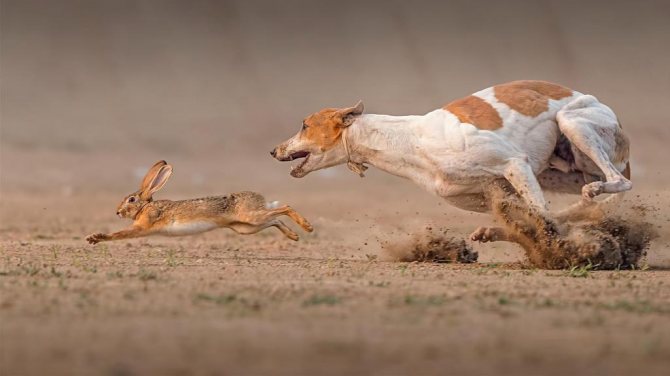
Hare hunting with hounds is one of the simplest, but at the same time exciting activities. While running, the animal can describe circles, throwing the hound off the scent. After the chip, young pets will return to their owner, and more experienced hunters will continue to look for the trail, prowling around. Over time, the hare's circles will become smaller and smaller, and rest stops will become more frequent. In the end, hunting a hare with hounds will lead to the capture of game.
Among the master cops, the rut goes quite smoothly with slight lulls. The trend will gradually increase, depending on mining fatigue. The training of a hound for hare hunting must be carried out using a special method.
Features of hunting with hound dogs
Hound dogs are a collective image. The hunting hound breed is one of the most extensive and is represented by more than forty species of hunting dogs. The thing is that hunting with hounds is one of the most ancient types of hunting with four-legged assistants. The main purpose of this breed corresponds to the initial task in hunting - to find the animal, pick it up and chase it with barking, letting the hunter understand the route of the prey. This required good instincts, endurance, viscosity and a good voice. It is on the development of these qualities that the selection of all breeds of hound dogs is based.
Hunting with Russian hounds to this day is one of the most sporting, exciting and rewarding, both in central Russia and beyond the Urals in the forest-steppe and forest zones. Hunting in the taiga zone with hounds is not common, but there are also lovers of these dogs. The development of the breed is based on European breeds, but has a long history, and therefore can rightfully be considered a native Russian hunt.
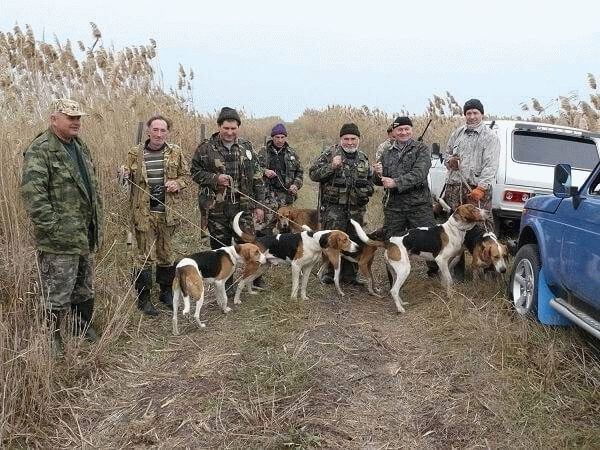
For a hare with a hound
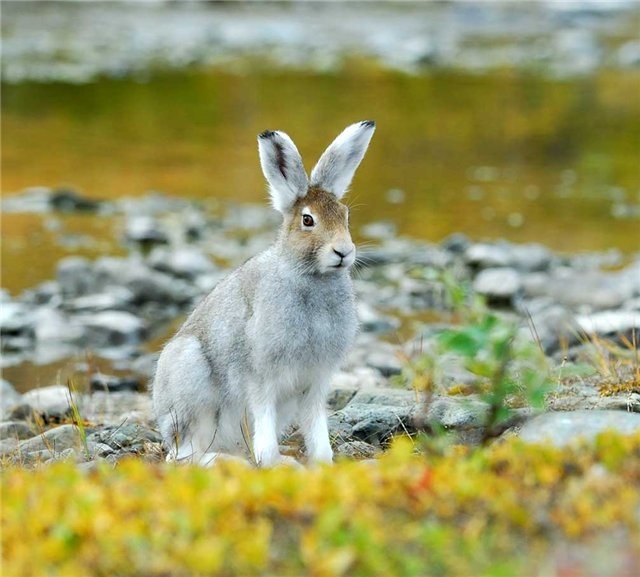
“Your dogs are rubbish! They saw me standing in this clearing, they kicked me around for more than two hours, but they never kicked me out. Why the hell should we keep people like that?!”
This statement reflects one of the deepest misconceptions in the field of hunting with hounds. “The dogs must be able to drive the animal to where they know the hunter is waiting for it.” And so, following this naive idea, the hunter, at the beginning of the rut, stops at any, often the most inappropriate, place. He is only concerned about whether his four-legged assistants know where he has settled and, therefore, where they need to “catch up” the prey. Let a hare pass somewhere very close to him over and over again - he will not budge, expecting that the “careless” dogs will eventually complete their task and “wrap” the animal “where it is needed.”
As a result, the hunter in the vast majority of cases will not even see the hare, and remaining, as they say, a “priest,” he will blaspheme and curse the hounds. But there is nothing to blame the dogs for. The hound follows the trail of the beast and cannot in any way change the direction of its movement. The hunter himself must guess or notice where there is the greatest probability of intercepting a hare fleeing from a dog and have the opportunity to shoot at it. This is the key to success.
Hares during the rut almost always walk around the land in circles. These circles, or rather irregular closed lines, often have a rather intricate configuration. The animal runs not just “wherever it looks,” but through very specific areas of fields or forests, where it is easier for him to walk or where he hopes to get rid of the dog’s pursuit as quickly as possible. Apparently, each animal has its own “tracts” in its lands, since each hare walks in its own way during the rut. But these paths of individual animals often intersect or converge in some places. Wherever hares are raised in a given area, each of them will definitely, and more than once, pass through such favorite “holes”. These places can be very different in nature: a crossroads of roads or clearings, a lintel connecting two sections of a thicket, an edge, a gap in a fence, the edge of a ditch, a bridge over a stream, etc. In addition, the hare every now and then returns to its bed, that is, to the place where it was raised. The circular course of the hare is often interspersed with direct transitions from one area of land to another and back.
The brown hare usually walks very widely. It can go several kilometers from the place of rise, so that even the sonorous voice of a hound will be lost in the distance. It can roll a circle of two or three kilometers in diameter across the land and will not come out to its resting place soon. In this case, he will most often follow fields, roads, boundaries and edges of ditches, and when entering the forest, he will stick to clearings, clearings and wide clearings.
The white hare is a completely different matter. He usually walks in smaller circles and always tries to climb through the strongest place. A thicket of young growth, a forest with dense undergrowth and undergrowth, a dry or frozen swamp with willows and high mown grass, a cluttered overgrown clearing - these are its favorite places to move. The hare will always cross a clearing where it is narrowest; from one thicket to another it will move where they come together closest; if it runs along a clearing or forest road, it will be a little, and most often it will only jump over them.
Guided by these behavioral characteristics of hares, you should choose a place for the rut. Hunting with hounds for a long time in the same area, you quickly manage to find out the places of constant hare transitions. In new places, you have to choose a hole, taking into account only the nature of the terrain, knowledge of the hare's habits and the direction of the rut.
When hunting with hounds, many, especially young hunters, make the same mistake - they move around too much, trying to intercept the hare. As soon as the dog’s voice becomes distant, they already leave the chosen hole and rush to where the rut is coming from. At the same time, they forget, firstly, that the hare walks much ahead of the dog and, trying to be as close as possible to the latter, we most often end up where he has already passed. Secondly, the hare will always hear a person rushing to intercept him and turn to the side, avoiding a dangerous meeting. Thus, constantly running from place to place and almost on the heels of chasing a hound, you will not kill a hare. Moreover, on collective hunts, such behavior will definitely disturb your comrades. Running under the hounds knocks the hare off the course he has chosen, he begins to walk straight, goes far, and it becomes difficult to wait for him even on the right hole.
The first thing you should do when you hear the rut has begun is to try to determine as accurately as possible the place where the animal was raised. As already mentioned, the resting place is the most reliable place for waiting for a hare, the surest hole. Usually, after the first circle, the animal returns here to double and confuse the trail. Sometimes he does not come to the prone immediately, but after two, three or more circles, but he always comes and gets shot. If it was not possible to determine the place of rise, then you need to try to determine the direction of movement of the hare by the sound of the rut and try to intercept it in some place suitable for its movement. Having stood on the manhole, you need to wait calmly, maintaining silence and relative stillness. It makes sense to leave the chosen point only if you can hear from the sound of the rut that the animal passes over and over again in the same place. It is clearly advisable to go there. When occupying a hole, you need to make sure that there is a wide enough view to shoot at the hare.
These are the rules of conduct for a hunter when hunting with hounds, the fulfillment of which is the key to success under other favorable conditions, i.e., good work of the dogs, the presence of an animal in the area and favorable weather.
Many dogs, not just hounds, are capable of lifting a hare from its bed by stumbling upon it or finding it along fat tracks. Huskies, a continental pointer, a dachshund, and even some of the most common mongrels can chase an animal for some distance (sometimes a very long one) silently or with a voice. However, real hunting of hares from under a dog is only possible with hounds. It is the latter that have very specific properties necessary for this hunt. These include: a persistent desire to find the beast at any cost; tireless pursuit of him along the trail, accompanied by the constant return of his voice, which in a hound should be sonorous and informative; the ability to quickly understand all the tricks that the beast resorts to to confuse its trail. If a hound has these properties, then even the most inexperienced, novice hunter will eventually kill a hare. If the dog searches lazily, pursues the animal for a short time, does not know how or does not want to find the lost trail, or chases the animal silently, then killing a hare from under it is often beyond the capabilities of even experienced hunters.
Even a good dog often takes a long time to lift a hare. This especially happens on days when the night tracks of animals are washed away by rain or covered with snow. A hare lying down gives off little scent and is difficult for a dog to smell. Under these conditions, the hunter can help the dog induce the scythe. To do this, it is worthwhile, without sparing yourself, to make your way through those, sometimes very inconvenient for walking, places where the hare is most likely to lie. In this case, it is useful to shout, crackle dead wood or tap on tree trunks in order to “wake up” the hare.
On a black trail (while the ground is not yet covered with snow) for hunting with hounds, the best days are quiet, windless, cloudy days, when both the ground and the layer of fallen leaves washed down by the rains are soft and wet, when the still air is filled with tiny particles of moisture, and the gray sky seems to be descending onto the motionless tops of bare trees. These days, the hare's trail is more odorous and retains its scent longer. The hounds on the soft trail do not knock their feet, and their voices reach the hunter especially loudly. It doesn’t matter if it drizzles, but it’s fine rain, falling as if through a sieve, not covering the traces and not immediately washing away their smell. The same thing happens after snow falls. The rut is good in relatively mild, calm weather, but without snowfall. The worst conditions for hunting are dry or frosty weather, as well as strong winds, in which it is very easy to lose dogs' hearing. On days that are unfavorable for hunting, it is better not to walk with dogs at all.
The hare is not susceptible to wounds, especially when shot hits its front part. However, it requires a gun with a fairly sharp fire and the corresponding shot numbers. The fact is that when shooting at long distances, with a low sharpness of the gun’s strike or with excessively small shot, the shot gets confused, rolls up in thick hare’s fluff, and its impact is weakened.
In the fall, a hare can be killed with shot number 5, but by winter, when it finally fades, it is best to use shot number 3 - number 1 (depending on the firing of the gun).
When you see a hare walking at your feet, there is absolutely no need to try to let it go as close as possible. From ten to fifteen steps, when the charge is fired by a bullet, it is very easy to miss, and the accuracy of the sight, which at thirteen to forty steps would ensure a sure hit, turns out to be insufficient here. Not only is it easy to miss, but if the charge hits the animal, it will literally make a hole in it. We must not forget that hare skins are valuable fur raw materials, that they should be handed over to procurement organizations and we should not be indifferent to the quality of the skins.
Even in moments when the animal runs especially fast, rushes, as they say, as fast as it can, at a distance of up to fifty steps there is no need to take any special lead when aiming. The stolen hare should be completely covered by the barrels so that only its ears are visible above the gun's front sight. When shooting at an oncoming hare, you need to aim at the tips of its front paws. A hare passing by a hunter needs to aim directly in front of the chest.
A wounded hare should either be shot, or, caught by the hind legs and lifted, finished off with a blow to the ribs of the palm behind the ears. Taking a wounded hare by the ears, especially when its legs are directed towards the hunter, is dangerous - with a blow from its hind legs it can cause quite serious injuries. Unfortunately, among hunters there are still quite frequent cases of attempts to finish off or crush a wounded hare with the butt of a gun. Such attempts, at best, lead to a break in the neck of the stock; at worst, you can get shot in the stomach if there is a loaded cartridge in one of the gun barrels, and the hammer breaks off the cock due to the impact.
It is better to go hunting with hounds from the very early morning, so that by dawn you can already be at the hunting site. At this time, dogs can still smell the scent of night hare tracks well and find the animal more easily. Then it makes sense to let the hound search directly from the places of supposed hare fat - from winter fields, field edges, large clearings and forest edges. Only on days with strong morning frosts does it make sense to delay the exit, wait until the trail softens a little. When two or three people hunt together with hounds, coordination of their actions is usually achieved by itself. You just need to remember that you are not supposed to shoot from a distance at a hare that is heading towards a comrade; You should not, having noticed that one of the companions has stood on a good hole, run ahead and stand in front of him in order to intercept the possible exit of the animal; Shooting towards a hunting comrade or at a vaguely visible target is completely unacceptable; It is impossible, even after seeing a hare, to replace dogs with shouts and shots if they are chasing at that time. Compliance with these rules is necessary at all times.
If you hunt with hounds in a group, then before the hunt you need to choose a leader. He is given the right to determine the direction of movement of the hunters, whistle to encourage and guide the dogs. He must monitor compliance by hunting participants with rules of conduct and safety. During the hunt, his orders are mandatory for all participants.
Failure to comply with the rules inevitably leads to the fact that nothing worthwhile comes from a collective hunt. Either the hunters will scatter across the land and lose each other, or one of them will stray to the side and drag the dogs along with them, or the whole harmony and the entire correct course of the hunt will be disrupted by the chaotic running around during the rut.
Participants in a collective hunt must walk calmly, stretched out in a narrow chain, in the direction chosen by the leader, guided by his voice. Only if someone sees a rising hare can they begin to call the dogs, if they are not chasing at that time.
With the start of the rut, all participants in the hunt must quickly choose places where they will wait for the animal to come out, and not leave them unless absolutely necessary.
Having killed a hare that has come out at him, the hunter should shout “ready” or “arrived” to notify his comrades of his success, but not leave the place until the dogs leave. The fact is that it is often not the rutting hare that is shot, but the noise hare, and after it is shot, the rutting continues. After shooting at a hare, if the latter is not killed, you need to listen carefully to the voice of the hound to see if it suddenly falls silent. If this happens, you should immediately rush to the place where the dog fell silent, since it is very possible that it either caught a wounded animal, or reached a dead hare after being wounded. The speed of such a check is the guarantee that you will find the hare more or less whole, and not torn to shreds or not eaten. Some hounds like to feast on hare meat away from their owner.
These are, perhaps, all the basic rules, the observance of which will make any young hunter a full member in the company of experienced hounds and sooner or later will ensure his hunting success.
Y. Rusanov Based on materials from the magazine “Hunting and Hunting Management”, 1973.
Hunting with a hound
Methods of hunting with a hound, as already mentioned, meet the most basic requirements for the help of a four-legged friend and assistant. Based on these principles, hunting with a hound is divided into two main types - complete, when with the help of hounds the animal is exposed to a pack of greyhounds, and walking with a gun, which is currently the main one. Complete hunting was often practiced for the “red beast,” wild boar, and other ungulates. It was used, first of all, for mass hunts, for squeezing animals out of steppe stakes under horsemen and under packs. The foot armory can develop in a very wide range. Hare hunting with hounds is popular, as well as wolf and fox hunting, wild boar, guran and even bear, which requires both certain qualities of the dog and special training for hunting and the experience of all members of the hunting team.
This is interesting: Hunting for wild boar with hounds
Hound or spaniel on a hare
Hunters often argue among themselves, proving that it is their dog that is best suited for hunting a hare. However, in addition to subjective ones (personal preference), there are also objective indicators of breeds that will influence the choice of dog. First, let's look at the canine characteristics:
| Index | Spaniel | Beagle |
| Adaptability | 5 | 4 |
| Education and training | 5 | 5 |
| Grooming | 3 | 2 |
| Friendliness in an unfamiliar environment | 4 | 4 |
| Child Friendly | 4 | 3 |
| Friendly to other dogs | 4 | 3 |
| Game activity | 4 | 5 |
| Intelligence | 5 | 4 |
| Apartment ratio | 4 | 2 |
| Observation | 5 | 5 |
| Need for exercise | 5 | 5 |
| Social need | 4 | 3 |
| Tendency to bark | 2 | 3 |
| Territoriality | 3 | 5 |
| Shedding level | 3 | 3 |
As can be seen from the table, both breeds have a high degree of adaptability, are easy to train, observant, have high intelligence, are quite friendly, and shed moderately. Both breeds require long periods of walking to satisfy their exercise needs. However, you should pay attention to the differences.
| Beagle | Spaniel |
| They need space. A large yard and a long walk are what is vital for a hound | Gets along well in an apartment. |
| Requires an owner with a strong-willed, strong character, tries to dominate in the absence of such | Friendly with all family members, gets along well even with small children |
| Height at withers 55-65 cm | Small dog, easy to transport |
| Skeleton and muscle mass are fully formed by 10 months | The skeleton and muscle mass are fully formed by 7-8 months - from this age you can train game |
| They hunt wolves, foxes, hares; able to follow the scent of wild boars and bears | They hunt pine, field, marsh, and waterfowl; small game (hare, squirrel) |
Based on the above, we can summarize:
- if you live in an apartment, you have a family with small children, and you do not plan to hunt big game, then your dog is a spaniel;
- If you have a yard, somewhere to walk your dog for a long time, and you are not interested in hunting birds and small game, then your dog is a Russian hound.
Main signs and characteristics of hound breeds
This article will consider only the most basic characteristics of breeds in their necessary qualities for hunting. The subtleties of separating different types of hounds are not so significant in hunting practice, although cynologists of hunting societies always try to adhere to the pan-European standard, which helps to maintain the purity, and therefore the remarkable working qualities of the dogs. The main characteristics of a hound: hanging ears, a body of medium massiveness and length with a fairly wide chest, a tucked belly and a straight back, a radish tail, i.e. tapering to the tip without feathering. Most hound dogs are short-haired.
- Ears do not play the main role in searching for animals, so hounds have closed ears that protect the hearing aid from damage. The same can be observed in hunting breeds for waterfowl and burrows. The hound’s main weapon is a subtle sense of smell and tirelessness in searching;
- namely the body, often close to the square type. The “knocked-down block” of this type of dog is an indicator of excellent physical shape. The tucked belly smoothly transitions to the groin without excessive retraction like a greyhound. The chest is wide enough, but not excessively. It is the average width of the body that makes it possible to withstand a strong opponent, while at the same time excessive width would be an obstacle to the speed characteristics of running. Of course, the pursuit speed of greyhounds is much higher; their narrow chest allows for excellent maneuvering while running, which is also inherent in a wolf. Hound breeds do not have the task of catching up with the animal, they only need to drive it out to the hunter. However, a meeting with a hunted animal can turn into a confrontation, which means that some of the fighting qualities must be preserved;
- The height of these dogs varies greatly among different breeds. Dachshund hounds, beagles, and basset hounds have short legs, which allows them to move well in dense thickets and penetrate shelters. Many types of European, English, French breeds, the Russian hound have a taller body and longer limbs. But in any case, the hound must have strong bones, the paw must be dense and elastic for good running. The position of the front shoulder blade is somewhat inclined, which in any hound gives it a slightly inclined silhouette. The hind leg forms an obtuse angle with the underbelly, the so-called “bow”. The body gains the well-known swiftness;
- The second most important quality, after physical form, is the voice. This is a unique quality of these dog breeds. A vyzhlovka or vyzhlovka must have a ringing, sonorous voice with a good timbre, “telling,” as hunters like to characterize it, i.e. heard from afar. In addition to the fact that this is one of the dog’s main tools in work, it is also, according to many fans, a decoration for hunting and communication with autumn nature, creating a certain flavor.
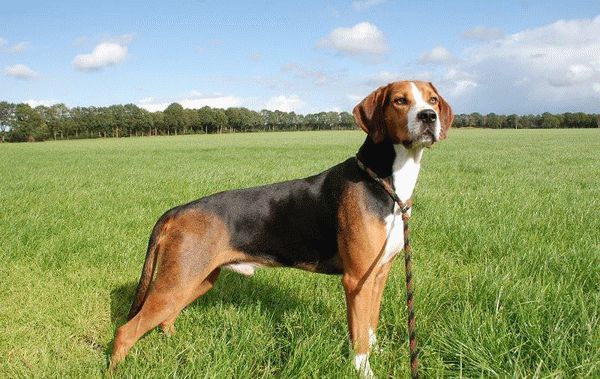
By the voice you can recognize which animal is being led by the survivor, the track or the “sighted” one, the degree of readiness of the animal, you can recognize all stages of the rut.
If the above characteristics and working qualities of a hound largely depend on the purity of the blood, they are inherited, which is a clear illustration of “why you should take a puppy only from purebred parents.” Other qualities of the dog, although they depend on the pedigree, are amenable to training and are brought to perfection with the help of education and training. Flair, tirelessness (tirelessness), viscosity (persistence), porosity (speed of the rut) are inherited. Obedience, loyalty (barking only at the right game), crawling (the ability to find an animal) are among the characteristics that are brought up.
Some aspects of hound training
As with raising any dog, it is necessary to develop the puppy’s independence, trust in the owner, obedience and toughness. But when training hounds, there are also special aspects, since in most cases the dog works at a considerable distance from the hunter and must show special qualities. The most important quality in this category is the ability not to “cut off the beast,” i.e. The dog must be viscous and not abandon the trail or the chasing animal when crossing easier prey. This is especially true when hunting hare.
This is interesting: How to get a hunting license for the first time: what you need, procedure for registration
Any qualities of a dog can only be achieved through constant communication with the pet, a thoughtful and patient attitude. Under no circumstances should you punish your dog.
There are also several rules that must be followed when training:
- Do not train a young dog with an old one; with a good dog, the puppy will not learn independence, but with a bad dog, he will take on all the shortcomings;
- do not go to training in a group, the dog should get used to listening to one owner;
- It’s better not to start training for powder, blacktrope develops all the best qualities, and powder will subsequently only prove to be a help;
- train the dog to drive in all weather conditions.
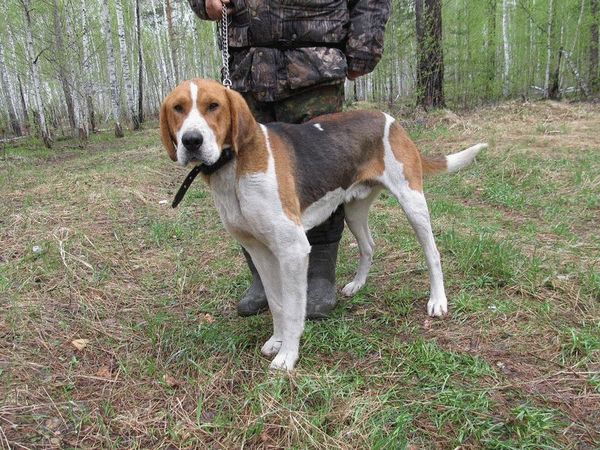
It is better to start training in April-May with frequent walks with the puppy, during which mutual understanding is easily established and the commands “come to me”, “sit” are practiced, and a response to the urge is developed. As during hunting, and especially during pursuit, one must not be distracted from the hunt or a specific animal. Thus, it is necessary to develop viscosity according to the beast, preventing chipping. With a young dog, you should give signals more often so that it knows the location of the owner. This will allow you to gradually expand your search circle. Spring surge is possible only at special training grounds or designated areas. If such training is impossible, one should not abandon walks, which are the precursor to the real training. But even if it was possible to train the dog in the spring, then in August the training continues, consolidating the achieved results and improving skills. It is worth noting that the bitch begins to work earlier than her male counterpart, but her hunting life is also shorter.
Types of hunting with the rut
For the hare
Hunting on foot with hounds is most often carried out for the hare. This is one of the most popular hunting objects, for which you can keep only one survivor, but it is better to have a group of two.
Hare hunting with a hound is, in principle, no different from ordinary foot tracking. The only, but significant, advantage is the excellent opportunity to find the animal along the black trail or along the “dead” powder. The principle of tracking itself is no different, only the hound carries it out. After the dog has unraveled the intricacies of the hare's loops and raised the oblique one, it gives a voice and begins the rut. The hunter just has to make the right shot. The peculiarity of training a young dog on a hare is the exceptional difficulty of reading the tracks, discounts, twos and threes of the cunning animal. Therefore, it is better to carry out the first searches for a hare at a very young age and untangle the trail together with your pet. Another method of catching can be based on active search in areas with a high density of animals, which helps to raise them in any case. Next comes the development of rutting skills. In this case, the hare's habit of following its trail is used. The hunter needs to have good knowledge of the area in order to properly “set” the dog, especially at the beginning of its hunting career. Subsequently, you can already work with the dog under any conditions.
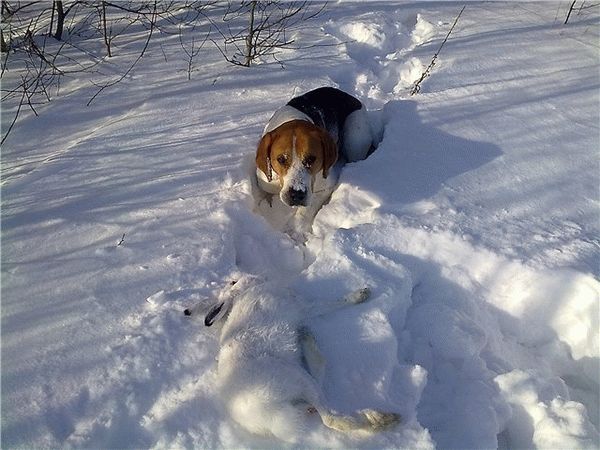
Hare hunting in winter with hounds
It hunts better in cloudy, windless weather. Dry frosty air makes it difficult to follow the trail, and in such weather the dog can become hypothermic and get sick.
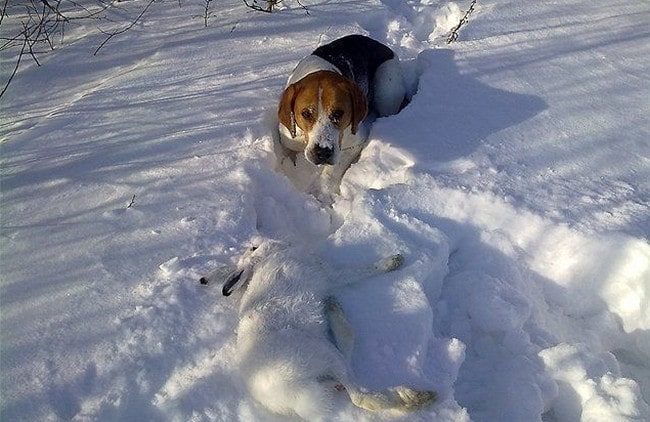
In winter they hunt:
- along the blacktop;
- along the white path;
- along the piebald (variegated) path - the snow on the path has melted in places.
You should go out in the dark so that when it dawns you can be at the hunting site. At such times it is easy to find a fresh hare trail. In the event that the hound cannot follow the trail, the hunter should make some noise to raise the scythe.
Attention! You should not hunt in deep snow. This is fraught with injuries (broken paws) and hypothermia in hounds.
